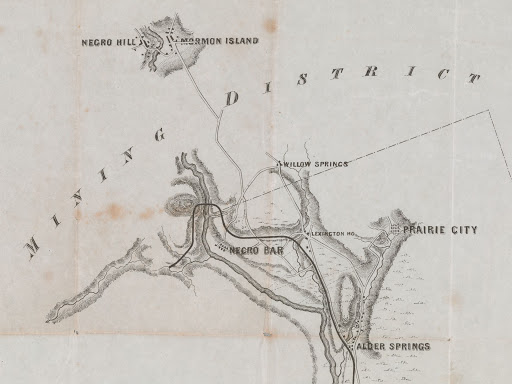From the Open-Publishing Calendar
From the Open-Publishing Newswire
Indybay Feature
Modern Day, "Lynch Mob" seeks to scrub the golden legacy of Negro Bar, Sacramento County
First Railroad West of the Continental Divide, From the City of Sacramento to Negro Bar, Sacramento County... soon pitched to be erased from history by a "Private" modern day "lynch mob" the authentic legacy of Negro Hill / Negro Bar Gold Mining District

The Sacramento Valley Railroad was incorporated in 1852 with ambitious plans to build rail service from the docs at Sacramento and westward expansion to San Francisco via ferry service at Alameda.
The railway was funded by a variety of California businessmen and fronted by Charles Lincoln Wilson as its “founder” and William Sherman as its first President.
The first part of the railroad was believed to be an easy engineering feat – the largest challenges being trestles over three creeks and a 600-foot embankment near the final approach to Negro Bar. But these ambitious plans fell apart.
Finding the right company to provide the engines, cars and build the ironworks for the rails seemed nearly impossible and almost finished the project before it even started. Licensing, regulations and right-of-way acquisition delayed the project for much of 1853 and 1854. All together, the railroad had spent more than half a million dollars before the first track was laid.
The original engineering company (Robinson, Seymour and Company) and chief engineer Lester Robinson sued for non-payment in 1855 – but were able to successfully settle, and Wilson narrowly survived a vote of “no confidence” from the board.
Robinson’s lawsuit resulted in Wilson being forced out of the railroad in 1855. The board appointed C.K. Garrison as its new president with W.T. Sherman becoming VP. Judah stayed on as chief surveyor, and Robinson became chief engineer.
Judah was laid off in 1856, and the company had no funding to continue expansion, so had no need of a surveyor and builder. Judah went looking for other investors and continued to develop railroads in the West.
Sherman’s bank failed in the Panic of 1857, and he left California never to return.
The SVRR struggled under its debt load, and failed to achieve its expansion dreams and lasting success.
The railway was funded by a variety of California businessmen and fronted by Charles Lincoln Wilson as its “founder” and William Sherman as its first President.
The first part of the railroad was believed to be an easy engineering feat – the largest challenges being trestles over three creeks and a 600-foot embankment near the final approach to Negro Bar. But these ambitious plans fell apart.
Finding the right company to provide the engines, cars and build the ironworks for the rails seemed nearly impossible and almost finished the project before it even started. Licensing, regulations and right-of-way acquisition delayed the project for much of 1853 and 1854. All together, the railroad had spent more than half a million dollars before the first track was laid.
The original engineering company (Robinson, Seymour and Company) and chief engineer Lester Robinson sued for non-payment in 1855 – but were able to successfully settle, and Wilson narrowly survived a vote of “no confidence” from the board.
Robinson’s lawsuit resulted in Wilson being forced out of the railroad in 1855. The board appointed C.K. Garrison as its new president with W.T. Sherman becoming VP. Judah stayed on as chief surveyor, and Robinson became chief engineer.
Judah was laid off in 1856, and the company had no funding to continue expansion, so had no need of a surveyor and builder. Judah went looking for other investors and continued to develop railroads in the West.
Sherman’s bank failed in the Panic of 1857, and he left California never to return.
The SVRR struggled under its debt load, and failed to achieve its expansion dreams and lasting success.
Add Your Comments
We are 100% volunteer and depend on your participation to sustain our efforts!
Get Involved
If you'd like to help with maintaining or developing the website, contact us.
Publish
Publish your stories and upcoming events on Indybay.
Topics
More
Search Indybay's Archives
Advanced Search
►
▼
IMC Network


